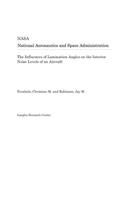
The Influences of Lamination Angles on the Interior Noise Levels of an Aircraft
Series:
The feasibility of reducing the interior noise levels of an aircraft passenger cabin through optimization of the composite lay up of the fuselage is investigated. MSC/NASTRAN, a commercially available finite element code, is used to perform the dynamic analysis and subsequent optimization of the fuselage. The numerical calculation of sensitivity of acoustic pressure to lamination angle is verified
NaN
VOLUME
English
Paperback

The feasibility of reducing the interior noise levels of an aircraft passenger cabin through optimization of the composite lay up of the fuselage is investigated. MSC/NASTRAN, a commercially available finite element code, is used to perform the dynamic analysis and subsequent optimization of the fuselage. The numerical calculation of sensitivity of acoustic pressure to lamination angle is verified using a simple thin, cylindrical shell with point force excitations as noise sources. The thin shell used represents a geometry similar to the fuselage and analytic solutions are available for the cylindrical thin shell equations of motion. Optimization of lamination angle for the reduction of interior noise is performed using a finite element model of an actual aircraft fuselage. The aircraft modeled for this study is the Beech Starship. Point forces simulate the structure borne noise produced by the engines and are applied to the fuselage at the wing mounting locations. These forces are the noise source for the optimization problem. The acoustic pressure response is reduced at a number of points in the fuselage and over a number of frequencies. The objective function is minimized with the constraint that it be larger than the maximum sound pressure level at the response points in the passenger cabin for all excitation frequencies in the range of interest. Results from the study of the fuselage model indicate that a reduction in interior noise levels is possible over a finite frequency range through optimal configuration of the lamination angles in the fuselage. Noise reductions of roughly 4 dB were attained. For frequencies outside the optimization range, the acoustic pressure response may increase after optimization. The effects of changing lamination angle on the overall structural integrity of the airframe are not considered in this study. Fernholz, Christian M. and Robinson, Jay H. Langley Research Center...
Price Comparison [India]
In This Series
Bestseller Manga
Trending NEWS




















